Birders sometimes use the term “LGB.” It stands for “Little Gray Birds” and is a shorthand way to note sightings of birds that are too unremarkable in plumage to ID.
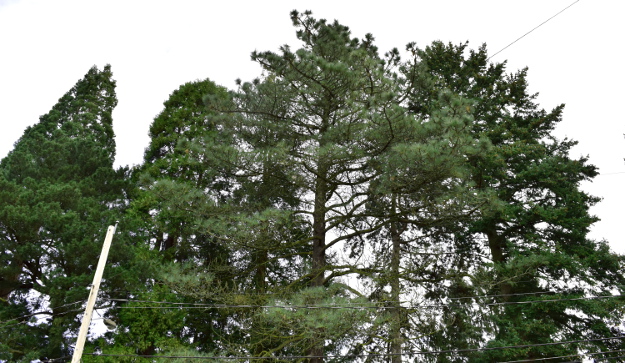
In the Pacific Northwest, we gardeners might adopt a similar lumping acronym: “BGC.” To the untrained eye, the bounty of evergreen trees here with soft sprays of foliage, like redcedars, Alaska-cedars, Port Orford cedars, arborvitaes, Hinoki cypresses, and leyland cypresses, seem like simply a bunch of “Big Green Conifers.” And that’s not even including the needled evergreen trees like firs, spruces, hemlocks, redwoods, and pines. I’m still learning how to sort them all out.
Upon closer inspection, though, each of these evergreen lookalikes reveals its charms—as I’m sure each little gray bird does, too, given the chance. One BGC that has long held a place in my heart is incense cedar (Calocedrus decurrens).
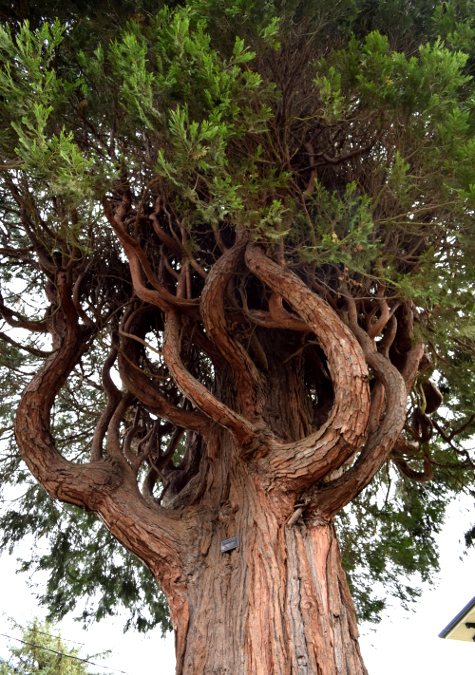
It’s the branching habit that does it for me.
If you look up from underneath the tree, you’ll see that incense cedar has a funky, wavy branching pattern. Thin branches typically make J-shaped attachments to the stout trunk, undulating as they extend upward.
Branches don’t always make a beeline for the top. Sometimes they make squiggly lines in all directions. This old tree has power lines running next to it on the south side (the right side of the picture), so most of the branches on that side have been lopped. The remaining branches saw what happened to their brothers and are veering away from that side of the tree!
I found this old fella on Southeast 37th Ave. via Phyllis Reynolds’ invaluable Trees of Greater Portland (Timber Press, 1993). She says it was probably planted in the 1920s, which would make it about 90 years old.
This incense cedar didn’t make the cut in Reynolds’ equally wonderful and much appreciated 2013 update to Trees of Greater Portland (Macrophyllum Press). The tree’s a bit thin, but look at the skimpy planting area the poor thing has to wiggle its toes in!
The neighbor who lives in the yellow house told me that this tree houses a family of raccoons.
She also told me that a couple of times a year, a scary-looking but benign insect emerges from the tree. “Hundreds of them, and they get in the house,” she said, though she reported that she’d gotten used to them over the years. She said an arborist had checked it out and told her it was a special “dinosaur insect” and that it did no harm. He recommended that nothing be done about it.
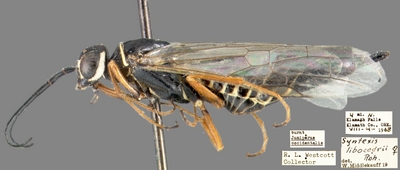
Intrigued, I looked it up when I got home and sure enough, I found that there’s a wood wasp (Syntexis libocedrii) known as a “living fossil” that feeds on incense cedar trees. It usually chooses trees that are still smoldering from a forest fire. The wood wasp family has indeed been around since the dinosaurs, though the Calocedrus genus, as far as we know, has “only” been around for 28 million years. Apparently, incense cedar hasn’t been the wood wasp’s only meal ticket in the past.
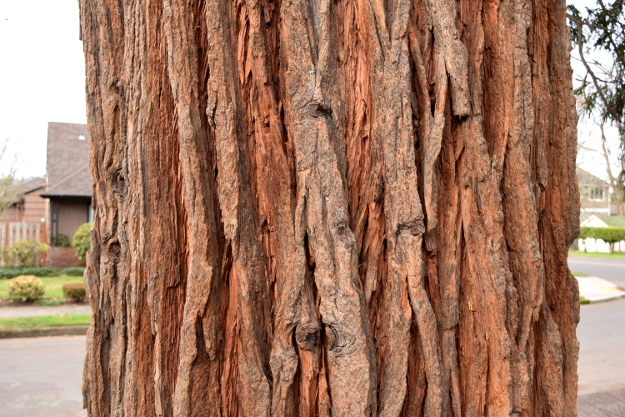
The bark on very old incense cedars is thick, pinkish-orange, and somewhat spongy. The aromatic wood (more on that later) is water-resistant and has been used in making window sashes, exterior siding, trellises, fencing, paneling, venetian blinds, chests, decking, greenhouse benches, and shoe trees.
Most famously, however, it’s used to make pencils, as the wood is soft and pencils made from it sharpen easily without splintering.
Have you ever wondered how they get the lead (graphite) into pencils? In his chapter on incense cedar in A Natural History of North American Trees (Houghton Mifflin Harcourt, 2007), Donald Peattie explains that a pencil is made from two halves. Each is carved with a groove to hold the lead, the lead is inserted, and the halves are glued together. So now you know.

The evergreen foliage of incense cedar is arranged in flattened sprays, as if they’d been pressed between the pages of a book. The pale yellow dots are the male flowers, which will release clouds of pollen in late winter.
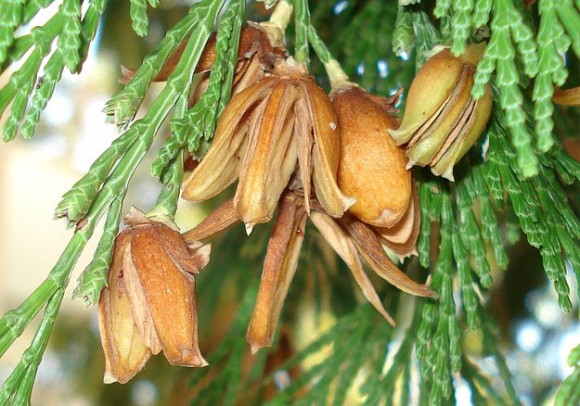
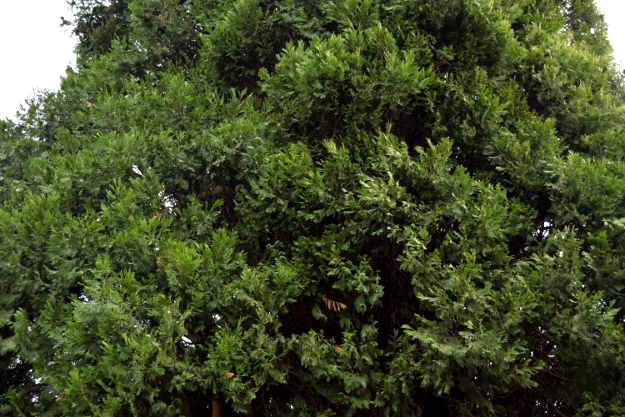
On this gentle giant on SE 55th Ave. (thanks again to Phyllis Reynolds), you can see a little better the flatness of the individual sprays of foliage. Incense cedar branches make nice additions to wreaths. The leaves are waxy and hold their color a long time.
The foliage and wood are full of resins and both have a spicy fragrance. When crushed, they smell like a mix of pencil shavings and—to my nose, anyway—parsnips!
This tree must give off a wonderful aroma on balmy days or after a rain (I love parsnips). Funny, in my reading I never did see any references to incense cedar actually being used as incense. I’m sure it must be.
And here’s what that giant incense cedar on 55th looks like in full. The house was built in 1904, but Reynolds suggests that the tree might pre-date the home. Calocedrus means “beautiful cedar.” I can’t imagine a more perfect specimen of this achingly beautiful species. It turns my knees to jelly.

Just look again at the branching habit on this baby.
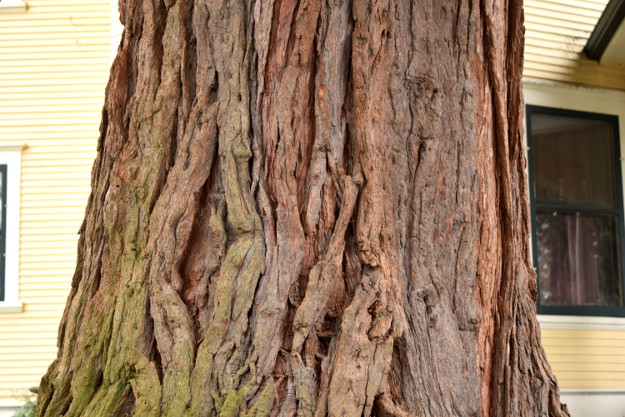
And the bark. Peattie says this species can live 1,000 years. This one seems determined to get there.
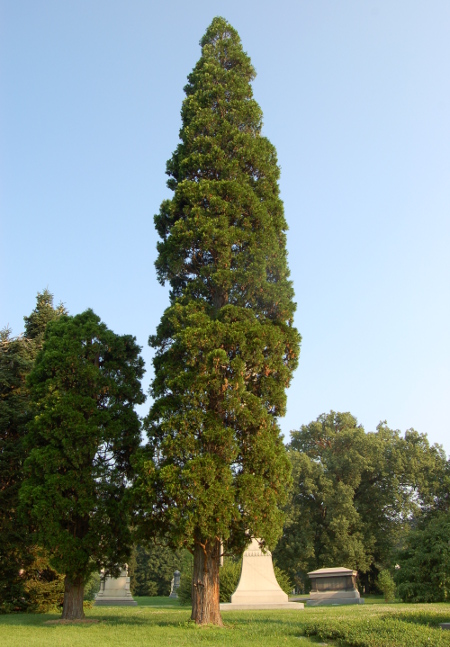
And this is where my love affair started. I first saw this tree in Spring Grove Cemetery in Cincinnati and loved its J-shaped branches and spicy pencil fragrance.
This one is probably pining for its Western homelands (and its sister is pining for its top), but it’s doing pretty well. Incense cedar is native to parts of Oregon and California and likes the dry summers that we can offer it, but it’s obviously adaptable to wetter, more humid conditions in the East. Dirr reports an 80-footer in Athens, Georgia and a 70-footer in Chapel Hill, North Carolina.
Incense cedar is hardy to Zone 5 and prefers a freely draining, slightly acidic soil. It’s a slow to moderate grower that tolerates shade but does better in full sun. It does need regular irrigation the first few years, until it gets firmly established.
Which Big Green Conifers do you think stand out from the crowd? Hopefully, incense cedar is one of them. Now if you’ll excuse me, I think there are some little gray juncos I need to console.


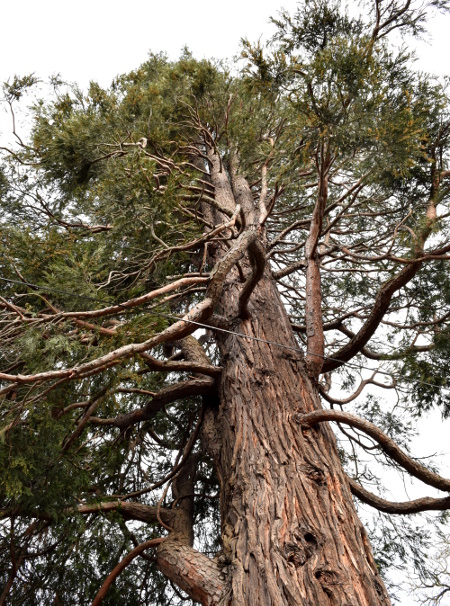
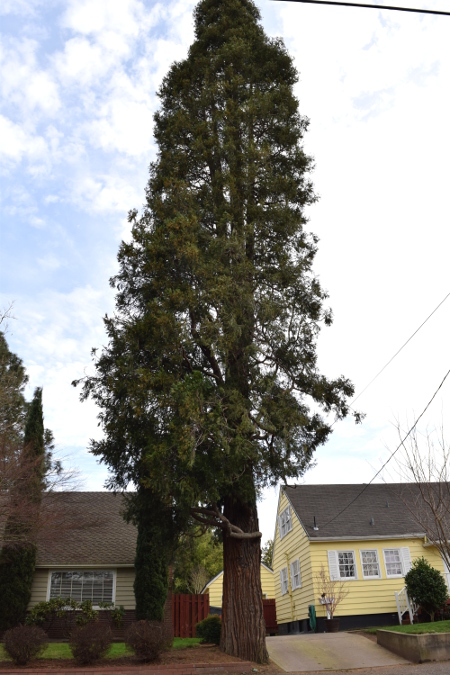
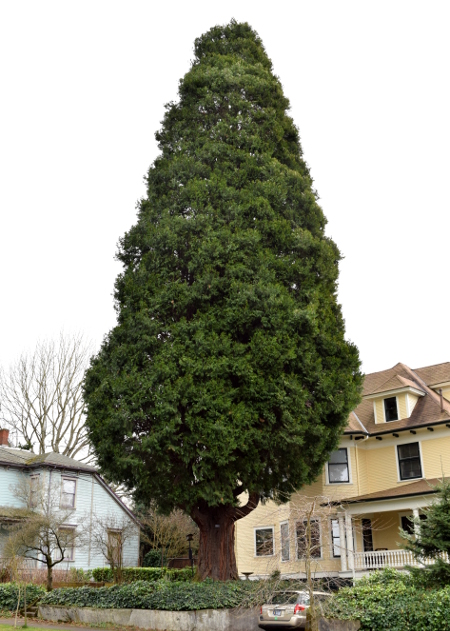
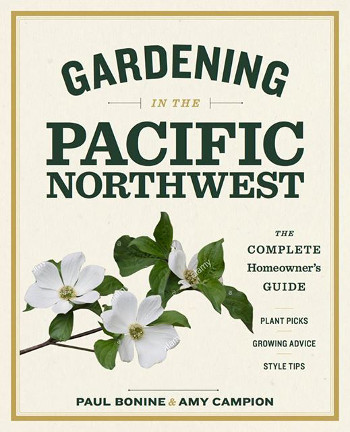























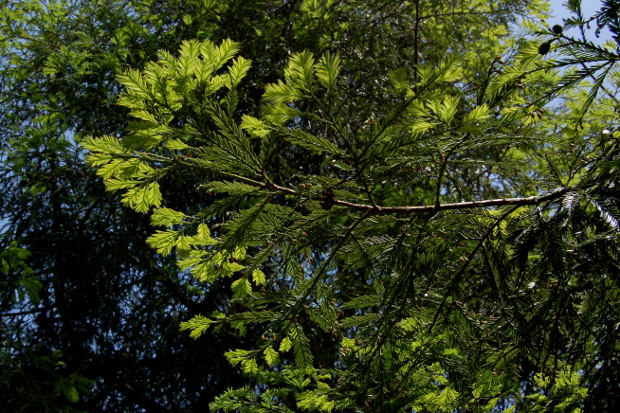


I was just going through pictures that John Waskiewicz took a few months ago in the Arnold Arboretum. The first pic in the album was of Calocedrus decurrens which triggered my recollection of that very same tree from 13-14 years previous. They may be plentiful in your part of the country but they are a very rare treat in the NE https://www.facebook.com/photo.php?fbid=884811124871547&set=a.884811048204888.1073741856.100000280030884&type=3&theater
Thank you, Amy, for this passionate article! I’ve been calling this tree the “Mystery Tree” because I could not identify it. Now I’m pretty sure that this is the one I’ve been so confused by!
Just read your blog as I’m in the process of writing up the Incense Cedar for my blog on our local arboretum. Love your photos! The one in my park is much smaller as it was only planted in 1996!
I love this tree! Nice blog post and thank you for the shout out.
I love Incense Cedars! Their shape is so elegant, and they smell delicious. And when I walk through a cluster of them during pollen season, I’m so grateful I’m still immune to the potential effects of those clouds of green.
The photo of the compensating branches made me sad. I really do think trees sort of are sentient beings, and we often treat them so poorly. Every time I see a tree mutilated due to crappy planting location or overhead wires, I wonder when we’re going to change the way we wire this country. It’s about time….
[…] is also interesting information at Incense-cedar, Calocedrus decurrens (incense-cedar) description, Incense Cedar | The World’s Best Gardening Blog, Incense Cedar | University of Redlands, Doreen Fogle: Incense Cedar — native, common and a great […]
I was looking up what other plants can grow with them, as my house is literally Surrounded by them in NE Portland (23 of them on my property..wooo)?
This article helped me confirm my suspicions on what type of onifer they are..so thank you!
incense cedar near peidmont hospital. can you tell me what road it is on ?
Thank you for this story. I planted a small one where I look out every day after a literature search 15-20 years ago, in the lee of a huge 90-year old silver maple. Yes we get a lot of wind. The most beautiful bright green all year long, it catches the sunset, now about 25’ tall, 12” caliper or more already. Always lively with birds. I had never seen one at the time but it turns out there are a few here on the coast of Rhode Island. Oregon conifers thrive here. Hinokis too. West coast of New England I call it. I confess to choking up over that photo of that tree on 55th st.